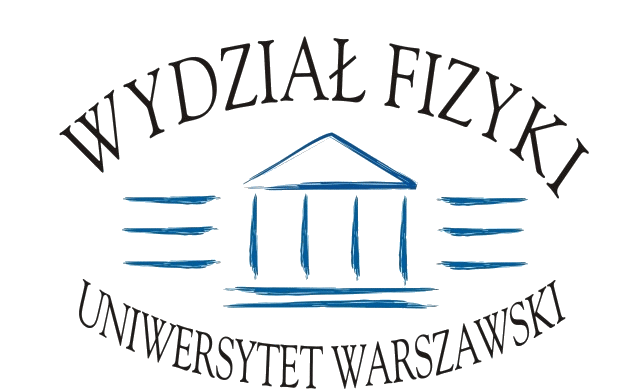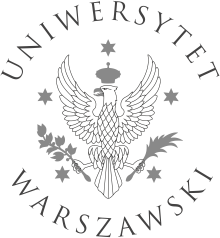2024-09-10 (Wtorek)
prof. Wiesław Królikowski (The Australian National University)
Structured light
The Australian National University
2024-07-03 (Środa)
prof. Heike Ebendorff-Heidepriem (The University of Adelaide)
Fiber optics and nitrogen-gap diamonds in ultra-low intensity spatial field measurements
wykład w ramach programu IDUB MENTOR
2024-06-20 (Czwartek)
dr inż. Sławomir Ertman (Zakład Optyki i Fotoniki, Wydział Fizyki, Politechnika Warszawska)
Dwu- i trójwymiarowe przestrajalne mikrostruktury światłowodowe
2024-06-06 (Czwartek)
Pawel Jung (University of Central Florida, USA The College of Optics & Photonics)
Optical Thermodynamics
2024-03-28 (Czwartek)
Xiang Feidi (Huazhong University of Science and Technology, Wuhan, China)
Fiber sensor based on magneto-optical effect
2024-03-14 (Czwartek)
mgr Bartosz Pałuba (Instytut Geofizyki FUW)
Przejawy PT-symetrii w światłowodach dwurdzeniowych
2024-03-07 (Czwartek)
dr Maciej Napiórkowski (Politechnika Wrocławska)
Optymalizacja przestrzennej separacji modów w nanostrukturalnych światłowodach kilku-modowych za pomocą odwrotnych sieci generatywnych
W słabo sprzężonych światłowodach kilku-modowych (FMF), stosowanych w optycznych systemach komunikacyjnych w celu zwiększenia przepustowości danych, krytycznym jest różnica między efektywnymi współczynnikami załamania kolejnych modów przestrzennych. W prezentacji przedstawione zostanie, że nanostrukturalne światłowody FMF składające się z dwóch różnych rodzajów szklanych prętów o rozmiarach podfalowych fali mogą być skutecznie wykorzystywane do kontrolowania właściwości propagacyjnych poszczególnych modów przestrzennych. Projektowanie i optymalizacja takich światłowodów okazuje się jednak wyzwaniem ze względu na dużą liczbę parametrów związanych z ich rozkładem. Aby rozwiązać ten problem, wykorzystano metodę optymalizacyjną opartą na odwrotnych sieciach generatywnych (GIDN) zmodyfikowanych w celu uwzględnienia właściwości optycznych słabo sprzężonych światłowodów FMF.
2024-02-22 (Czwartek)
dr Wenzhong Liu (Huazhong University of Science and Technology, Wuhan, China)
Advance in Temperature Imaging by Using Mganetic Nanoparticles
Magnetic nanoparticles have been proven to have a temperature resolution of 0.1 degrees. How to realize temperature imaging by using magnetic nanoparticles is currently one of the hot topics in the field of medical imaging. This talk will introduce the latest progress in magnetic nanotemperature imaging based on magnetic principles and future optical principles.
2024-01-22 (Poniedziałek)
prof. Alper Kiraz (Physics and Electrical-Electronics Engineering Department at Koç University)
In this talk, I will summarize the recent research projects we have been pursuing on Optofluidics and Biological Imaging.Fluids possess unique properties for designing optical components and systems: (i) they have optically smooth interfaces and (ii) they provide great flexibility in shape and refractive index. Optofluidics has emerged as an exciting new research field employing these unique properties of fluids to design optical components and systems that cannot be realized with classical solid-state materials. We used plasma oxidation and laser ablation for static and reversible modifications of hydrophobic surfaces along pre-defined patterns. We employed such hydrophilically patterned surfaces for optofluidic waveguide and microdroplet sorting applications. We used manual drilling or mold replication to fabricate microchannels in silica aerogel blocks. Following a silanization step, these microchannels were filled with water and used as optofluidic waveguides. We have demonstrated photochemical reactions using these novel optofluidic waveguides. We achieved bulk refractive index sensing with a limit of detection of around 10-5 refractive index units using optical fiber resonators. The same system also gave us good hydrogen sensing performance upon palladium and polymer coatings.On the topic of biological imaging, we built a light sheet fluorescence microscope for cleared tissue imaging, a structured illumination microscope using image scanning microscopy for super-resolution microscopy, and fiber bundle-based fluorescence imaging systems. Deep learning has triggered a revolutionary transformation in digital optical microscopy. Deep learning approaches that employ problem-specific deep neural network models have largely replaced standard image processing techniques such as thresholding and watershed transformation for processing optical microscopy images. In addition to data analysis, deep learning can also be used exquisitely to improve the overall performance of an optical microscope. Deep learning-enhanced approaches can be used to increase the signal-to-noise ratio, to obtain super-resolution images above the diffraction limit, or to create virtually stained images from images that do not contain any staining. I will discuss our recent works on novel deep learning-based solutions for automated cell counting and viability analysis, brain vasculature analysis, and improving the contrast and resolution of fluorescence microscopes.
Some Applications of Optofluidics and Deep Learning in Bio-Imaging, Bio/Chemical-Sensing, and Energy Photonics
The seminar will be conducted in English.
In this talk, I will summarize the recent research projects we have been pursuing on Optofluidics and Biological Imaging.Fluids possess unique properties for designing optical components and systems: (i) they have optically smooth interfaces and (ii) they provide great flexibility in shape and refractive index. Optofluidics has emerged as an exciting new research field employing these unique properties of fluids to design optical components and systems that cannot be realized with classical solid-state materials. We used plasma oxidation and laser ablation for static and reversible modifications of hydrophobic surfaces along pre-defined patterns. We employed such hydrophilically patterned surfaces for optofluidic waveguide and microdroplet sorting applications. We used manual drilling or mold replication to fabricate microchannels in silica aerogel blocks. Following a silanization step, these microchannels were filled with water and used as optofluidic waveguides. We have demonstrated photochemical reactions using these novel optofluidic waveguides. We achieved bulk refractive index sensing with a limit of detection of around 10-5 refractive index units using optical fiber resonators. The same system also gave us good hydrogen sensing performance upon palladium and polymer coatings.On the topic of biological imaging, we built a light sheet fluorescence microscope for cleared tissue imaging, a structured illumination microscope using image scanning microscopy for super-resolution microscopy, and fiber bundle-based fluorescence imaging systems. Deep learning has triggered a revolutionary transformation in digital optical microscopy. Deep learning approaches that employ problem-specific deep neural network models have largely replaced standard image processing techniques such as thresholding and watershed transformation for processing optical microscopy images. In addition to data analysis, deep learning can also be used exquisitely to improve the overall performance of an optical microscope. Deep learning-enhanced approaches can be used to increase the signal-to-noise ratio, to obtain super-resolution images above the diffraction limit, or to create virtually stained images from images that do not contain any staining. I will discuss our recent works on novel deep learning-based solutions for automated cell counting and viability analysis, brain vasculature analysis, and improving the contrast and resolution of fluorescence microscopes.
2023-12-14 (Czwartek)
Luming Zhao (Huazhong University of Science and Technology)
New method for characterizing soliton pulses in fiber lasers
2023-11-23 (Czwartek)
Yiwen Zhu (Huazhong University of Science and Technology, Wuhan, China)
The research is focused on the technique that investigates the application of the AC magneto-optical dichroism of magnetic fluids in fast and low-cost immunoassays by taking advantage of liquid optical cavities.
Magneto-optical immunoassay method based on cavity enhancement technology
The seminar will be held in English.
The research is focused on the technique that investigates the application of the AC magneto-optical dichroism of magnetic fluids in fast and low-cost immunoassays by taking advantage of liquid optical cavities.
2023-11-16 (Czwartek)
dr Adam Filipkowski (Sieć Badawcza Łukasiewicz - Instytut Mikoelektroniki i Fotoniki)
The remarkable quantum spin properties of negatively charged nitrogen-vacancy centers present in nanodiamond can be precisely controlled by applying microwaves, magnetic fields, and light, enabling their potential as high-precision sensors. Such sensors exploiting nanodiamond-functionalized optical fibers have been demonstrated to enable reaching sub-nT magnetic field sensitivities over localized magnetic field sources, but their potential for distributed sensing remains largely unexplored. The volumetric incorporation of nanodiamond particles into the optical core of the fiber creates the possibility of developing fibers that are sensitive to the magnetic field over their entire length. That approach combines the advantages of robust axial fixation of nanodiamonds with a direct spatial overlap of their fluorescence with the guided mode of the fiber.During the course of the QUNNA project we've developed three different optical fibres with integrated nanodiamonds. Two of those used dip coating method of nanodiamond deposition in order to fabicate a step-index fiber with the optical core volumetrically functionalized with nanodiamonds, and a suspended core fiber with 750 nm-diameter nanodiamonds located centrally in the 1.5 µm-core. For the third fibre we deposited nanodiamonds from a solvent suspension into a anti-resonant hollow core fiber. We've then tested their application for ODMR-based and microwave-free magnetic field gradiometry.
Włókna ze zintegrowanymi nanodiamentami do rozproszonych pomiarów magnetometrycznych
Fibres with integrated nanodiamonds for distributed magnetometry measurements
Niezwykłe kwantowe właściwości spinowe ujemnie naładowanych centrów wakancji azotowych obecnych w nanodiamentach mogą być precyzyjnie kontrolowane poprzez zastosowanie mikrofal, pól magnetycznych i światła, co umożliwia ich wykorzystanie jako precyzyjnych czujników. Wykazano, że takie czujniki wykorzystujące światłowody z funkcjonalizacją nanodiamentami umożliwiają osiągnięcie czułości pola magnetycznego poniżej nT w stosunku do zlokalizowanych źródeł pola magnetycznego, ale ich potencjał w zakresie rozproszonego wykrywania pozostaje w dużej mierze niezbadany. Objętościowe włączenie cząstek nanodiamentu do rdzenia optycznego światłowodu stwarza możliwość opracowania światłowodów wrażliwych na pole magnetyczne na całej ich długości. Podejście to łączy w sobie zalety trwałego wiązania nanodiamentów z bezpośrednim przestrzennym nakładaniem się ich fluorescencji z modem prowadzonym światłowodu.W trakcie trwania projektu QUNNA opracowano trzy różne światłowody ze zintegrowanymi nanodiamentami. W dwóch z nich zastosowano metodę zanurzeniową osadzania nanodiamentów w celu wytworzenia światłowodu o stopniowym indeksie z rdzeniem optycznym funkcjonalizowanym objętościowo nanodiamentami oraz światłowodu z zawieszonym rdzeniem z nanodiamentami o średnicy 750 nm umieszczonymi centralnie w rdzeniu o średnicy 1,5 µm. W przypadku trzeciego włókna nanoszono nanodiamenty z zawiesiny rozpuszczalnika do antyrezonansowego włókna z pustym rdzeniem. Następnie zbadano ich zastosowanie w gradiometrii pola magnetycznego opartej na ODMR.
The remarkable quantum spin properties of negatively charged nitrogen-vacancy centers present in nanodiamond can be precisely controlled by applying microwaves, magnetic fields, and light, enabling their potential as high-precision sensors. Such sensors exploiting nanodiamond-functionalized optical fibers have been demonstrated to enable reaching sub-nT magnetic field sensitivities over localized magnetic field sources, but their potential for distributed sensing remains largely unexplored. The volumetric incorporation of nanodiamond particles into the optical core of the fiber creates the possibility of developing fibers that are sensitive to the magnetic field over their entire length. That approach combines the advantages of robust axial fixation of nanodiamonds with a direct spatial overlap of their fluorescence with the guided mode of the fiber.During the course of the QUNNA project we've developed three different optical fibres with integrated nanodiamonds. Two of those used dip coating method of nanodiamond deposition in order to fabicate a step-index fiber with the optical core volumetrically functionalized with nanodiamonds, and a suspended core fiber with 750 nm-diameter nanodiamonds located centrally in the 1.5 µm-core. For the third fibre we deposited nanodiamonds from a solvent suspension into a anti-resonant hollow core fiber. We've then tested their application for ODMR-based and microwave-free magnetic field gradiometry.
2023-11-09 (Czwartek)
dr hab. inż. Alicja Anuszkiewicz (Politechnika Warszawska, Wydział Elektroniki i Technik Informacyjnych, Instytut Systemów Elektronicznych)
The seminar will be held in Polish.
Kształtowanie właściwości światłowodów ze sztuczną anizotropią
Światłowody ze sztuczną anizotropią to stosunkowo nowa klasa włókien optycznych, które łączą w sobie cechy światłowodu telekomunikacyjnego jak i utrzymującego polaryzację. Koncepcja sztucznej anizotropii pozwala kształtować właściwości polaryzacyjne światłowodu bez użycia powszechnie stosowanych stref naprężających w płaszczu włókna. To z kolei pozwala na rozszerzenie koncepcji na włókna aktywne i o dużej powierzchni modu oraz na włókna wielordzeniowe czy obrazowody polaryzacyjne.
The seminar will be held in Polish.
2023-10-19 (Czwartek)
mgr Joanna Starobrat (Wydział Fizyki Politechniki Warszawskiej)
The seminar will be held in Polish.
Redukcja wyższych rzędów ugięcia dyfrakcyjnego w odtworzeniach próbkowanych hologramów Fouriera
W odtworzeniach hologramów Fouriera wyświetlanych na ciekłokrystalicznych przestrzennych modulatorach światła (LCoS SLM) obecne są powielenia żądanego obrazu. Prezentowane wyniki dowodzą, że redukcja widoczności tych powieleń jest możliwa poprzez zmianę struktury pikseli, np. poprzez użycie masek apodyzacyjnych czy ulosowienie położeń pikseli.
The seminar will be held in Polish.






